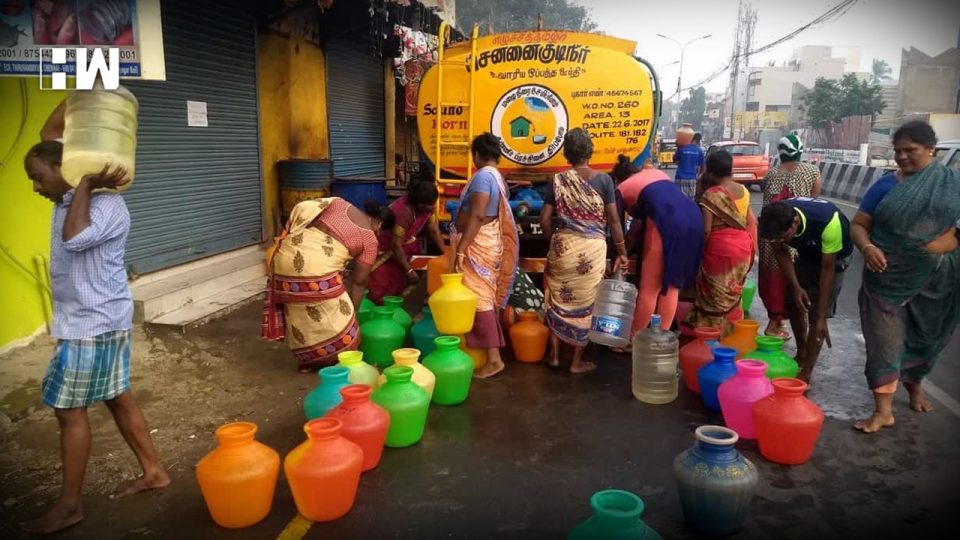Hundreds of residents lining up behind a water truck with plastic pots in their hand might seem a little off in any city, but in Chennai, it has become a common sight.
Chennai, the sixth largest city of India is seeing one of its worst water crisis. All their lakes and groundwater have dried up. There was no monsoon for 200 days, and there will not be one, not for a while, according to the forecasts.
In a report released on 14 June, the top government thinktank for the economy, NITI Aayog, said India was facing the worst water crisis in its history. It predicted that 21 cities would run out of groundwater by 2020.
The government is trying out all the measures it can, including but not limited to: asking temples to pray for early rains.
Many IT companies have asked their employees to work from home, and several hotels and restaurants have closed down. Some of the restaurants have taken off half the food off their menu, and have switched to paper plates to reduce water consumption.

Madras HC came down heavily on the state government
Governments in India are not known for their prompt and quick action.
The four reservoirs supplying the bulk of the city’s drinking water have completely dried up, leading the Chennai Metro Water to cut the water it provides by about 40%.
The Madras High Court has blamed the state government, accusing it of acting impassively until the situation became unavoidable. The court accused the government of waiting for the arrival of the monsoon instead of proactively handling the water crisis which, it said, did not happen in a day.
“The reasons for the water shortage are complex but experts cite as one reason unplanned urban development that has destroyed the wetlands around the city. There is little or no recycling of water or rainwater harvesting”, a Guardian report says.
It also pointed out that politicians relied upon the predicted rainfall so much that when the actual crisis hit, there were no proper policies or measures implemented to control the situation.
Meanwhile, there’s Chief Minister K Palaniswami’s nonchalant attitude
While everyone else is running waywardly towards any water source, the Chief Minister seems quite relaxed, and “urged the media to not hype the situation”.
The emergent situation has not changed the mind of CM K Palaniswami, who still insists on waiting out till rainfall.
He said that deficient monsoon had resulted in depletion of groundwater levels, but maintained that the issue wasn’t big. The CM said the state was largely dependent on groundwater to meet the requirements till the onset of the northeast monsoon in October.
“The [northeast] monsoon will arrive only by October-November. Till then we have to meet the requirements only from groundwater sources,” he said.
Are the water tankers sufficient?
Residents all across Chennai have been struggling to book water tankers, where a lottery system decides who gets to draw water from the dark depths. Most of the residents have been forced to book the water tankers since the taps are running dry.
This has led to more demand than supply and in some cases, the tankers are being delivered a month late, which in turn has multiplied the prices.
As usual, low wage workers and the poor are suffering.“We had been booking private tankers a month in advance. But now even that isn’t an option since certain restrictions have been imposed. When we approach them, they tell us to come after 15-20 days. The level of crisis is extreme. We are depending on water cans now, but they are very expensive,” told a Kodambakkam resident to News18.
They pay up to Rs 1,500 and are having to shell out money for tips as well.
According to official sources, the total water demand in the city is 950 million litres per day (MLD), whereas the supply is 750 MLD, including 200 MLD from private tankers. That leaves a dangerous deficit of 200 MLD, and activists say the deficit is even higher.
Moreover, water tankers hardly cover their food and drinking needs. Scarcely any water remains for laundry or cleaning.

Hospital patients are suffering, too
The water crisis has hit the hospitals in Chennai along with other organisations too. Some of the public toilets are not left with any remnant groundwater and have shut down.
In hospitals, almost everyone can be seen carrying a one-litre bottle of water in their hands. The top private hospitals like Rajiv Gandhi have enough money to buy or store the water.
An average hospital consumes 1.6 lakh litres of water daily, all of it sourced from tankers. The government hospitals are able to source water on a concession, while the small private ones are forced to pay an exorbitant sum. The patients are made to carry their own water.
A Down to Earth report from as early as 2015 notes suburban residents of Sivaji Nagar, Tiruvengadam Nagar, Santhosh Nagar and Himachal Nagar complaining that the groundwater in the region is no longer fit for use as it was being contaminated by a factory nearby.
The TN govt advised people to dig borewells where water supply is optimum and also spoke of an understanding with the Andhra Pradesh government over water sharing. More money has been allotted to new digging of borewells.
As an independent media platform, we do not take advertisements from governments and corporate houses. It is you, our readers, who have supported us on our journey to do honest and unbiased journalism. Please contribute, so that we can continue to do the same in future.

